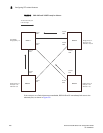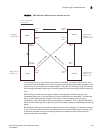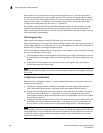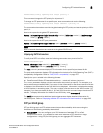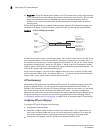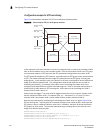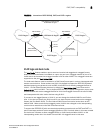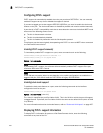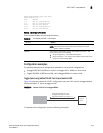
272 PowerConnect B-Series FCX Configuration Guide
53-1002266-01
Configuring STP related features
8
• Single STP – Single STP allows all the VLANs to run STP, but each VLAN runs the same instance
of STP, resulting in numerous blocked ports that do not pass any Layer 2 traffic. STP per VLAN
group uses all available links by load balancing traffic for different instances of STP on
different ports. A port that blocks traffic for one spanning tree forwards traffic for another
spanning tree.
STP per VLAN group allows you to group VLANs and apply the same STP parameter settings to all
the VLANs in the group. Figure 51 shows an example of a STP per VLAN group implementation.
FIGURE 51 STP per VLAN group example
A master VLAN contains one or more member VLANs. Each of the member VLANs in the STP Group
runs the same instance of STP and uses the STP parameters configured for the master VLAN. In
this example, the PowerConnect switch is configured with VLANs 3, 4, 13, and 14. VLANs 3 and 4
are grouped in master VLAN 2, which is in STP group 1. VLANs 13 and 14 are grouped in master
VLAN 12, which is in STP group 2. The VLANs in STP group 1 all share the same spanning tree. The
VLANs in STP group 2 share a different spanning tree.
All the portss are tagged. The ports must be tagged so that they can be in both a member VLAN
and the member's master VLAN. For example, ports 1/1 – 1/4 are in member VLAN 3 and also in
master VLAN 2 (since master VLAN 2 contains member VLAN 3).
STP load balancing
Notice that the STP groups each have different STP priorities. In configurations that use the STP
groups on multiple devices, you can use the STP priorities to load balance the STP traffic. By
setting the STP priorities for the same STP group to different values on each device, you can cause
each of the devices to be the root bridge for a different STP group. This type of configuration
distributes the traffic evenly across the devices and also ensures that ports that are blocked in one
STP group spanning tree are used by another STP group spanning tree for forwarding. Refer to
“Configuration example for STP load sharing” on page 274 for an example using STP load sharing.
Configuring STP per VLAN group
To configure STP per VLAN group,do the following:
• Configure the member VLANs.
• Optionally, configure master VLANs to contain the member VLANs. This is useful when you
have a lot of member VLANs and you do not want to individually configure STP on each one.
Each of the member VLANs in the STP group uses the STP settings of the master VLAN.
• Configure the STP groups. Each STP group runs a separate instance of STP.
Member
VLAN 3
Member
VLAN 4
Member
VLAN 13
Member
VLAN 14
STP group 1
Master VLAN 2
Member VLAN 3
Member VLAN 4
STP priority 1
STP group 2
Master VLAN 12
Member VLAN 13
Member VLAN 14
STP priority 2
Switch





